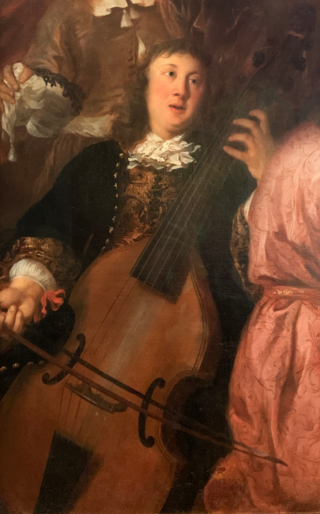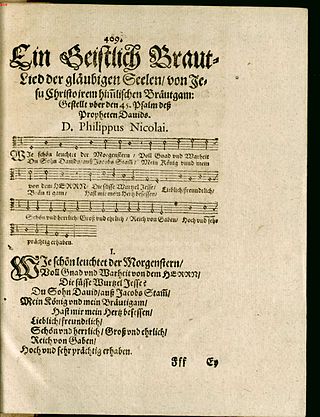Johann Pachelbel was a German composer, organist, and teacher who brought the south German organ schools to their peak. He composed a large body of sacred and secular music, and his contributions to the development of the chorale prelude and fugue have earned him a place among the most important composers of the middle Baroque era.

Dieterich Buxtehude was a Danish composer and organist of the Baroque period, whose works are typical of the North German organ school. As a composer who worked in various vocal and instrumental idioms, Buxtehude's style greatly influenced other composers, such as Johann Sebastian Bach and George Frideric Handel. Buxtehude is considered one of the most important composers of the 17th century.

Partita was originally the name for a single-instrumental piece of music, but Johann Kuhnau, his student Christoph Graupner, and Johann Sebastian Bach used it for collections of musical pieces, as a synonym for suite.
The Bach-Werke-Verzeichnis is a catalogue of compositions by Johann Sebastian Bach. It was first published in 1950, edited by Wolfgang Schmieder. The catalogue's second edition appeared in 1990. An abbreviated version of that second edition, known as BWV2a, was published in 1998.
Wilhelm Hieronymus Pachelbel was a German composer and organist, the elder son of Johann Pachelbel.

The title Notebook for Anna Magdalena Bach refers to either of two manuscript notebooks that the German Baroque composer Johann Sebastian Bach presented to his second wife, Anna Magdalena. Keyboard music makes up most of both notebooks, and a few pieces for voice are included.
Georg Böhm was a German Baroque organist and composer. He is notable for his development of the chorale partita and for his influence on the young J. S. Bach.

The sonatas and partitas for solo violin are a set of six works composed by Johann Sebastian Bach. They are sometimes referred to in English as the sonatas and partias for solo violin in accordance with Bach's headings in the autograph manuscript: "Partia" was commonly used in German-speaking regions during Bach's time, whereas the Italian "partita" was introduced to this set in the 1879 Bach Gesellschaft edition, having become standard by that time. The set consists of three sonatas da chiesa in four movements and three partitas in dance-form movements. The 2nd Partita is widely known for its Chaconne, considered one of the most masterful and expressive works ever written for solo violin.

The English Suites, BWV 806–811, are a set of six suites written by the German composer Johann Sebastian Bach for harpsichord and generally thought to be the earliest of his 19 suites for keyboard, the others being the six French Suites, the six Partitas and the Overture in the French style. They probably date from around 1713 or 1714.
Wolfgang Friedrich Rübsam is a German-American organist, pianist, composer and pedagogue.

Johann Sebastian Bach was a German composer and musician of the late Baroque period. He is known for his prolific output across a variety of instruments and forms, including the orchestral Brandenburg Concertos; solo instrumental works such as the cello suites and sonatas and partitas for solo violin; keyboard works such as the Goldberg Variations and The Well-Tempered Clavier; organ works such as the Schübler Chorales and the Toccata and Fugue in D minor; and choral works such as the St Matthew Passion and the Mass in B minor. Since the 19th-century Bach Revival, he has been widely regarded as one of the greatest composers in the history of Western music.

The Great Eighteen Chorale Preludes, BWV 651–668, are a set of chorale preludes for organ prepared by Johann Sebastian Bach in Leipzig in his final decade (1740–1750), from earlier works composed in Weimar, where he was court organist. The works form an encyclopedic collection of large-scale chorale preludes, in a variety of styles harking back to the previous century, that Bach gradually perfected during his career. Together with the Orgelbüchlein, the Schübler Chorales, the third book of the Clavier-Übung and the Canonic Variations, they represent the summit of Bach's sacred music for solo organ.

The Bach-Busoni Editions are a series of publications by the Italian pianist-composer Ferruccio Busoni (1866–1924) containing primarily piano transcriptions of keyboard music by Johann Sebastian Bach. They also include performance suggestions, practice exercises, musical analysis, an essay on the art of transcribing Bach's organ music for piano, an analysis of the fugue from Beethoven's 'Hammerklavier' sonata, and other related material. The later editions also include free adaptations and original compositions by Busoni which are based on the music of Bach.

The Canonic Variations on "Vom Himmel hoch da komm' ich her", BWV 769, are a set of five variations in canon for organ with two manuals and pedals by Johann Sebastian Bach on the Christmas hymn by Martin Luther of the same name. The variations were prepared as a showpiece for Bach's entry as fourteenth member of Mizler's Music Society in Leipzig in 1747. The original printed edition of 1747, in which only one line of the canon was marked in the first three variations, was published by Balthasar Schmid in Nuremberg. Another version BWV 769a appears in the later autograph manuscript P 271, which also contains the six trio sonatas for organ BWV 525–530 and the Great Eighteen Chorale Preludes BWV 651–668. In this later version Bach modified the order of the variations, moving the fifth variation into a central position, and wrote out all the parts in full, with some minor revisions to the score.
These [variations] are full of passionate vitality and poetical feeling. The heavenly hosts soar up and down, their lovely song sounding out over the cradle of the Infant Christ, while the multitude of the redeemed "join the sweet song with joyful hearts." But the experiences of a fruitful life of sixty years have interwoven themselves with the emotions which possessed him in earlier years ... The work has an element of solemn thankfulness, like the gaze of an old man who watches his grandchildren standing round their Christmas tree, and is reminded of his own childhood.
The brilliant scale passages not only represent the ascending and descending angels, but sound joyous peals from many belfries ringing in the Saviour's birth.

"Wie schön leuchtet der Morgenstern" is a Lutheran hymn by Philipp Nicolai written in 1597 and first published in 1599. It inspired musical settings through centuries, notably Bach's chorale cantata Wie schön leuchtet der Morgenstern, BWV 1, but also vocal and instrumental works by Baroque composers, Peter Cornelius, Felix Mendelssohn, Max Reger, Hugo Distler, Ernst Pepping, Mauricio Kagel and Naji Hakim.
"Auf meinen lieben Gott" is a Lutheran hymn from the 17th century. Several hymns are sung to the same hymn tune, including "Wo soll ich fliehen hin", and it was set in compositions. The hymn was translated into English as "In God, My Faithful God". It is part of modern hymnals and songbooks.
Sei gegrüßet, Jesu gütig, BWV 768, also known as Partite diverse sopra "Sei gegrüßet, Jesu gütig", is a chorale partita for organ by Johann Sebastian Bach.

Daniel Vetter was an organist and composer of the German Baroque era.







